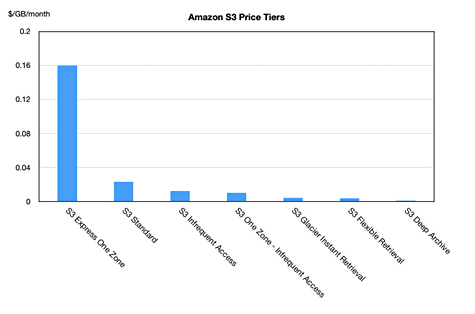AWS has introduced an S3 Express One Zone tier (S3 1XZ) to speed up small object access latency by up to 10x.
The announcement was made at AWS re:Invent 2023, and S3 1XZ co-locates AWS EC2, ECS, and ELS compute in the same availability zone as the storage, reducing the latency of compute to object storage access. AWS Chief Evangelist Jeff Barr blogs that latency to the first byte is in the single-digit milliseconds area compared to S3 standard, whose latency is described as milliseconds, and which we can now deduce to be double-digit milliseconds.

Barr makes the point that time to first byte is pretty close to time for last byte for small objects, unlike with large objects where data streaming time lengthens with object size. So S3 1XZ is, he says, ideal for data-intensive applications with hundreds or thousands of parallel compute nodes accessing small objects, such as AI/ML training, financial modeling, media processing, real-time ad placement, and high performance computing. It can deliver a significant reduction in runtime compared to S3 standard class.
No actual performance benchmarks have been supplied by Amazon.
The pricing is the usual Amazon maze of numbers, and based on capacity and activity. S3 1XZ is almost seven times more expensive per GB per month at $0.16 than S3 Standard’s $0.023 for the first 50 TB/month, and even higher than the next 450 TB’s $0.022/month and the $0.0021/month AWS charges for more than 500 TB.

S3 standard charges $0.005 per 1,000 PUT, COPY, POST, and LIST requests, and $0.0004 per 1,000 for GET, SELECT, and all other requests. S3 1XZ halves these charges to $0.0025 and $0.0002 respectively.
Barr makes the point that S3 1XZ’s lower latency and request costing “means that your Spot and On-Demand compute resources are used more efficiently and can be shut down earlier, leading to an overall reduction in processing costs.”
The new S3 class is implemented by having a new directory bucket type, a new bucket naming method, and new authentication model. Barr’s blog has coded implementation examples.
Amazon S3 Express One Zone is available in the US East (N Virginia), US West (Oregon), Asia Pacific (Tokyo), and Europe (Stockholm) Regions, with plans to expand to others over time.








